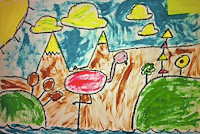Ravinia Fifth Grade Art Thus Far...
Now that I have my blog up and running, I am going to show you what we've been up to so far this year. It's been an exciting year so far! We've learned about careers in art, made oil pastel flowers, sculpted plaster cakes, and painted mini masterpieces.
Careers in the Arts
Have you ever wondered what it would be like to be a landscape architect, video game designer, or work in advertising? At the beginning of the school year we discussed these different careers and many more. Click on the link below to learn more about different careers in the arts!
Learn about careers in the arts here!
Students began by drawing their flower outlines in pencil. They colored each petal using a monochromatic range or a spectrum of colors utilizing the color wheel. The center of each flower was filled in using a radial sunburst coloring effect.
Students followed colors around the color wheel to create a natural flow of color. They concentrated on creating highlights in the petals, stems, and leaves. The final touch was a black oil pastel outline to clean up edges. They are currently on display in the first & fifth grade hallways.
 Wayne
Thiebaud is one of the original Pop Art Movement artists. He painted
everyday objects like gumball machines, popsicles, and you guessed
it...cakes!
Wayne
Thiebaud is one of the original Pop Art Movement artists. He painted
everyday objects like gumball machines, popsicles, and you guessed
it...cakes!
 Wayne
Thiebaud is one of the original Pop Art Movement artists. He painted
everyday objects like gumball machines, popsicles, and cakes.
Wayne
Thiebaud is one of the original Pop Art Movement artists. He painted
everyday objects like gumball machines, popsicles, and cakes.
 Students
chose a simple object to make a mini painting. They drew multiple
sketches to develop their composition and transfered the image
through a reverse transfer method or by simply drawing it onto the
canvas.
Students
chose a simple object to make a mini painting. They drew multiple
sketches to develop their composition and transfered the image
through a reverse transfer method or by simply drawing it onto the
canvas.
 Once
the image was on the canvas, they applied color theory to mixing the
appropriate colors with their paint.
Once
the image was on the canvas, they applied color theory to mixing the
appropriate colors with their paint.
vanGogh's Oil Pastel Flowers
Fifth grade students examined the painting “Sunflowers” by Vincent van Gogh and created large blooming flowers of their own design. Concepts included in this composition were the construction of a radial design, highlight and lowlight placement, and leading parts of the composition off the edge of the design surface.
Students began by drawing their flower outlines in pencil. They colored each petal using a monochromatic range or a spectrum of colors utilizing the color wheel. The center of each flower was filled in using a radial sunburst coloring effect.
Students followed colors around the color wheel to create a natural flow of color. They concentrated on creating highlights in the petals, stems, and leaves. The final touch was a black oil pastel outline to clean up edges. They are currently on display in the first & fifth grade hallways.
Wayne Thiebaud Plaster Cakes
 Wayne
Thiebaud is one of the original Pop Art Movement artists. He painted
everyday objects like gumball machines, popsicles, and you guessed
it...cakes!
Wayne
Thiebaud is one of the original Pop Art Movement artists. He painted
everyday objects like gumball machines, popsicles, and you guessed
it...cakes!
Using
his art and the food art of reality shows such as Sweet
Genius, Cake Boss, and Ace of Cakes,
students designed their own cakes. They created their cakes using
molds and plaster gauze, painted them with acrylics, and embellished
them with items brought from home or sculpey clay creations. Can
you guess the theme of their cakes?
Each
one is different and unique!
Mini Masterpieces
Mini Masterpieces
 Wayne
Thiebaud is one of the original Pop Art Movement artists. He painted
everyday objects like gumball machines, popsicles, and cakes.
Wayne
Thiebaud is one of the original Pop Art Movement artists. He painted
everyday objects like gumball machines, popsicles, and cakes. Students
chose a simple object to make a mini painting. They drew multiple
sketches to develop their composition and transfered the image
through a reverse transfer method or by simply drawing it onto the
canvas.
Students
chose a simple object to make a mini painting. They drew multiple
sketches to develop their composition and transfered the image
through a reverse transfer method or by simply drawing it onto the
canvas. Once
the image was on the canvas, they applied color theory to mixing the
appropriate colors with their paint.
Once
the image was on the canvas, they applied color theory to mixing the
appropriate colors with their paint.
Lastly,
they embellished their painting with Sharpie markers.




















